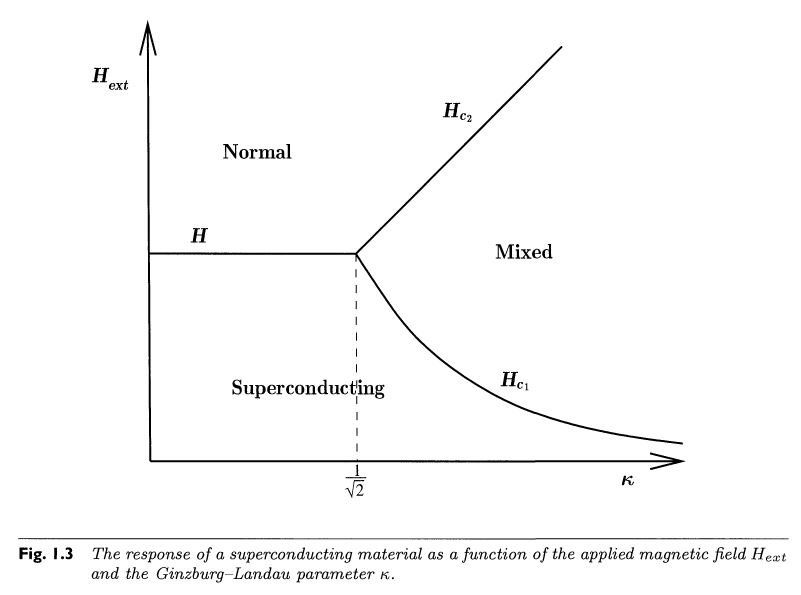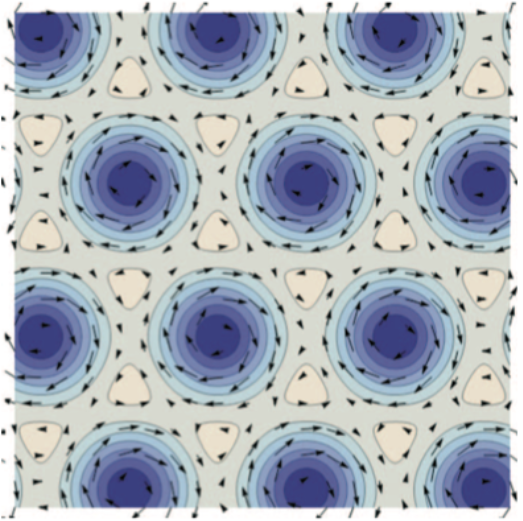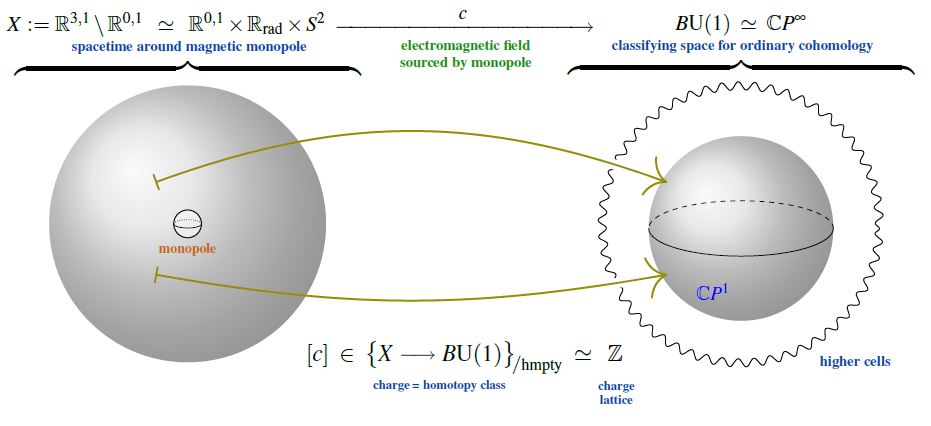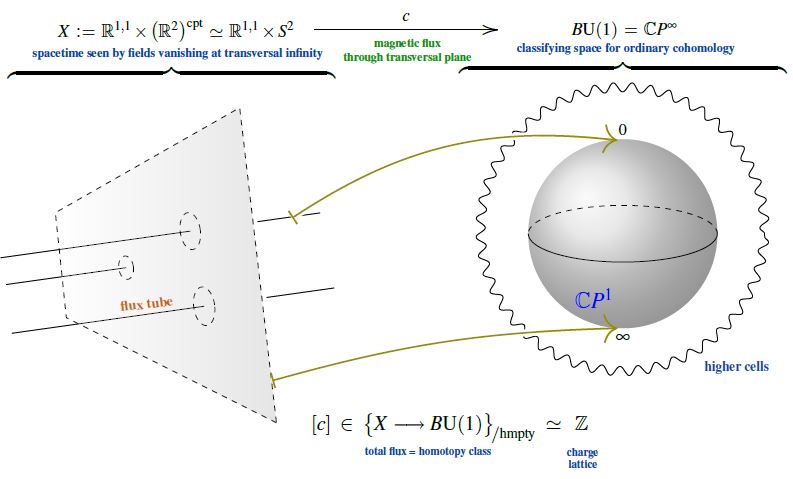nLab vortex
Context
Physics
physics, mathematical physics, philosophy of physics
Surveys, textbooks and lecture notes
theory (physics), model (physics)
experiment, measurement, computable physics
-
-
-
Axiomatizations
-
Tools
-
Structural phenomena
-
Types of quantum field thories
-
Contents
Idea
A kind of soliton.

Examples
Magnetic flux quantization in type II superconductors
Due to the Meissner-Ochsenfeld effect, a superconductor placed in a sufficiently small external magnetic field (aligned along some axis) “expels” that field , making the total magnetic field in the bulk of the superconductor vanish. However, as the ambient magnetic field exceeds a critical value , this behaviour changes:
-
for type I superconductors, the superconducting state simply breaks down as and the ambient magnetic field fully penetrates the material as for any normal conductor;
-
for type II superconductors the superconducting state eventually also breaks down as , but there is an intermediate parameter region where both regimes mix:

In this mixed regime, a finite number of elementary units of magnetic flux enter the superconductor, carried by little flux tubes inside vortices of electric currents: vortex strings (about a micron in diameter, e.g. Chapman 00, p. 559). Each vortex core carries one unit of magnetic flux – also called a fluxon – while at some small finite distance away from all vortices, the bulk magnetic flux in the superconductor still vanishes (mathematically: it vanishes at infinity, cf. eg. Chapman 2009 (2.31), Timm 2020 (6.101)) :

At sufficiently large density these vortices arrange into hexagonal patterns, first described by Abrikosov 57, whence also known as Abrikosov vortices.

This flux quantization in type II superconductors is traditionally explained via the effective field theory provided by the Landau-Ginzburg model; the derivation may be found reviewed in Chapman 00 (Section 2, culminating in (2.33)).
But, as indicated a little more explicitly in Alvarez-Gaumé 98 (Section IV.B, culminating below IV.11), the flux quantization as such is mathematically a direct consequence of the global topological nature of the electromagnetic field, the argument being the direct 2-dimensional analog of the quantization of instantons in QCD in 4d (see also at SU(2)-Instantons – From the correct maths to the traditional physics story) and in fact is but a slight variation of the argument for Dirac charge quantization of magnetic monopoles:
Namely, the electromagnetic field is a connection on a circle bundle, and hence the cohomology classifying space for the topological class of the electromagnetic field is the classifying space of the circle group, which, being an Eilenberg-MacLane space , has second homotopy group the integers:
This implies that on every spacetime which looks, up to homotopy equivalence, like a 2-sphere to the electromagnetic field, the magnetic flux is identified with an element in the group of integers, hence is quantized in integral multiples of some unit flux.
For the case of a (hypothetical) magnetic monopole (e.g. a magnetically charged black hole), it is the spacetime around the monopole (the complement of its worldline in the ambient (asymtptotically) Minkowski spacetime ) which has the homotopy type of a 2-sphere ; this implies the Dirac charge quantization of the magnetic monopole‘s magnetic charge:

For the case of the type II superconductor it is instead the transversal vanishing at infinity of the magnetic field (i.e. the Meissner-Ochsenfeld effect away from the vortices) which implies that the classifying map of the electromagnetic field sees not the full transversal Euclidean plane but its one-point compactification , which introduces an effective 2-sphere topology onto spacetime (same as the 3-sphere in the discussion of Skyrmions and the 4-sphere in the discussion of instantons): . This implies the superconductor’s magnetic flux quantization:

The argument that is given in most references, via consideration of the period of the vector potential on a large circle around the superconductor (e.g. Timm 20, Section 5.3), is secretly just the analysis of this picture through the clutching construction (the direct 2d analog of the discussion at SU(2)-Instantons – From the correct maths to the traditional physics story).
Vortex anyons
See Votex anyons at braid group statistics.
Related concepts
References
General
A historical abandoned but influential speculation on vortex strings:
Reviews and surveys:
-
David Tong, TASI Lectures on Solitons (web), part 3: Vortices (pdf)
-
Roberto Percacci, section 2.6 in: Non-Perturbative Quantum Field Theory – An Introduction to Topological and Semiclassical Methods, SISSA & ICTP (2024) [doi:10.22323/9788898587056, pdf]
On water vortices forming knots:
- Dustin Kleckner and William T. M. Irvine, Creation and dynamics of knotted vortices, Nature Physics 9 (2013) 253–258 [doi:10.1038/nphys2560]
On quantum vortices as in superconductors or Bose-Einstein condensates/superfluids:
-
Rufus Phillips, Quantum Vortices.
-
Erkki Thuneberg, Superfluidity and Quantized Vortices
-
K. R. Sreenivasan, Vortices, particles and superfluidity (pdf, pdf)
Discussion via AdS/CMT:
- Markus A. G. Amano, Minoru Eto, Holographic Global Vortices with Novel Boundary Conditions [arXiv:2404.03212]
On stable vortex knots in Bose-Einstein condensates:
- Yuta Nozaki, Yuya Koda, Muneto Nitta: Quantum Knots that Never Come Untied Michikazu Kobayashi [arXiv:2410.07470]
Defect anyons
Often the concept of anyons is introduced as if a generalization of particle statistics of perturbative quanta like fundamental bosons and fermions. But many (concepts of) types of anyons are really solitonicdefects such as vortices whose braiding phases are adiabatic Berry phases.
The general concept of braiding of defects in solid state physics:
- N. David Mermin, The topological theory of defects in ordered media, Rev. Mod. Phys. 51 (1979) 591 doi:10.1103/RevModPhys.51.591
(including a review of basic homotopy theory)
and more specifically for vortices:
- Hoi-Kwong Lo, John Preskill, Non-Abelian vortices and non-Abelian statistics, Phys. Rev. D 48 (1993) 4821 [doi:10.1103/PhysRevD.48.4821]
Explicit discussion as defect anyons:
- Alexei Kitaev, Anyons in an exactly solved model and beyond, Annals of Physics 321 1 (2006) 2-111 [doi:10.1016/j.aop.2005.10.005]
[p. 4:] “Anyonic particles are best viewed as a kind of topological defects that reveal nontrivial properties of the ground state.”
and with focus on defect anyons in momentum space:
- Hisham Sati, Urs Schreiber: Anyonic topological order in TED K-theory, Reviews in Mathematical Physics 35 03 (2023) 2350001 [doi:10.1142/S0129055X23500010, arXiv:2206.13563]
Anyonic defects which act as genons, changing the effective genus of the ambient 2D surface:
-
Maissam Barkeshli, Xiao-Liang Qi: Topological Nematic States and Non-Abelian Lattice Dislocations, Phys. Rev. X 2 031013 (2012) [doi:10.1103/PhysRevX.2.031013, arXiv:1112.3311]
-
Maissam Barkeshli, Chao-Ming Jian, Xiao-Liang Qi: Twist defects and projective non-Abelian braiding statistics, Phys. Rev. B 87 (2013) 045130 [doi:10.1103/PhysRevB.87.045130, arXiv:1208.4834]
-
Xiao-Liang Qi: Defects in topologically ordered states, talk notes (2014) [pdf, pdf]
-
Maissam Barkeshli, Michael Freedman: Modular transformations through sequences of topological charge projections, Phys. Rev. B 94 (2016) 165108 [doi:10.1103/PhysRevB.94.165108, arXiv:1602.01093]
and specifically in quantum Hall systems:
-
Maissam Barkeshli, Xiao-Liang Qi: Synthetic Topological Qubits in Conventional Bilayer Quantum Hall Systems, Phys. Rev. X 4 (2014) 041035 [doi:10.1103/PhysRevX.4.041035, arXiv:1302.2673]
-
Andrey Gromov: Geometric Defects in Quantum Hall States, Phys. Rev. B 94 085116 (2016) [doi:10.1103/PhysRevB.94.085116]
see also:
- Simon Burton, Elijah Durso-Sabina, Natalie C. Brown: Genons, Double Covers and Fault-tolerant Clifford Gates [arXiv:2406.09951]
and their potential experimental realization:
- Zhao Liu, Gunnar Möller, Emil J. Bergholtz: Exotic Non-Abelian Topological Defects in Lattice Fractional Quantum Hall States, Phys. Rev. Lett. 119 (2017) 106801 [doi:10.1103/PhysRevLett.119.106801]
Concrete vortexanyons in Bose-Einstein condensates:
-
B. Paredes, P. Fedichev, J. Ignacio Cirac, Peter Zoller: 1/2-Anyons in small atomic Bose-Einstein condensates, Phys. Rev. Lett. 87 (2001) 010402 [doi:10.1103/PhysRevLett.87.010402, arXiv:cond-mat/0103251]
-
Julien Garaud, Jin Dai, Antti J. Niemi, Vortex precession and exchange in a Bose-Einstein condensate, J. High Energ. Phys. 2021 157 (2021) [arXiv:2010.04549]
-
Thomas Mawson, Timothy Petersen, Joost Slingerland, Tapio Simula, Braiding and fusion of non-Abelian vortex anyons, Phys. Rev. Lett. 123 (2019) 140404 [doi:10.1103/PhysRevLett.123.140404]
and in (other) superfluids:
- Yusuke Masaki, Takeshi Mizushima, Muneto Nitta, Non-Abelian Half-Quantum Vortices in 3P2 Topological Superfluids [arXiv:2107.02448]
and in condensates of non-defect anyons:
- Michele Correggi, Romain Duboscq, Douglas Lundholm, Nicolas Rougerie: Vortex patterns in the almost-bosonic anyon gas, Europhys. Lett. 126 (2019) 20005 [doi:10.1209/0295-5075/126/20005, arXiv:1901.10739]
On analog behaviour in liquid crystals:
- Alexander Mietke, Jörn Dunkel: Anyonic defect braiding and spontaneous chiral symmetry breaking in dihedral liquid crystals, Phys. Rev. X 12 (2022) 011027 [arXiv:2011.04648, doi:10.1103/PhysRevX.12.011027]
See also Ahn, Park & Yang 19 who refer to the band nodes in the Brillouin torus of a semi-metal as “vortices in momentum space”.
And see at defect brane.
Last revised on December 20, 2024 at 20:40:28. See the history of this page for a list of all contributions to it.